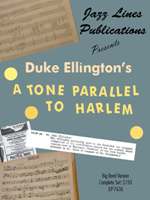TONE PARALLEL TO HARLEM, A [COMPLETE SCORE ONLY - DOWNLOAD]
Arranged by Duke Ellington, Prepared by Rob DuBoff, Dylan Canterbury, and Jeffrey Sultanof

Cat #: JLP-7636S-DL
$85.00This product is available for immediate download after purchase.
Questions?
Please call +1-518-587-1102 or email us.
Edition: Jazz Big Band Arrangement
Description: Advanced
Publisher: Jazz Lines Publications
Background of A Tone Parallel to Harlem (AKA The Harlem Suite):
Duke Ellington always had a sophisticated air about him. His high-brow comportment was evidenced in his dress, eloquent delivery and substance of his speech, and, of course, in his musical composition. Always striving to bridge the gap between ‘serious music’ (i.e., classical music) and popular music (jazz), even some of his earlier pieces such as East St. Louis Toodle-Oo (1926) take the listener on a rhapsodic journey through varying moods and scenes. He was never content to solely produce formulaic 32-bar songs; though he did that with aplomb. As the 1930s wore on he became increasingly inspired by long form composition. After all, a longer work allowed Ellington the opportunity to feature more of his cast of unique soloists and their individual sound and would provide further evidence of his goal of being recognized by the academic community as a composer and not just a band leader.
Ellington’s 1931 piece Creole Rhapsody shows the composer’s early attempt at breaking out of the popular music conventions. After the death of his mother in 1935, Ellington created Reminiscing in Tempo, a longer composition that is a set of variations. 1941 saw the debut of Ellington’s human rights-themed musical Jump for Joy, the first large scale stage production to introduce discussion of the historical and present day treatment of the “American Negro.” The musical had a run of nine weeks at the Mayan Theater in Los Angeles. Shortly after the completion of this show Ellington embarked on his most ambitious project to date: an opera titled Boola. This work, while never completed, was meant to offer further evidence and discourse regarding the plight of African Americans. As his compositional focus changed during the course of 1942, Ellington wound up using the overall structure, themes, and lyrics of Boola in the planning of 1943’s Black, Brown, and Beige. The January 1943 performance of this work represented a milestone in the life of Ellington as well as the burgeoning civil rights movement: his Carnegie Hall concert would also be the first occasion of a non-white band appearing at the venue. Ellington and his music were now officially installed in one of the most hallowed concert halls, and despite the mixed reviews of the performance and composition, Duke Ellington was now officially recognized as an important American composer.
1950 the NBC Symphony Orchestra commissioned Ellington to write an orchestral work with New York City as the inspiration. There is considerable debate as to whether Arturo Toscanini was personally involved in the commissioning process. Since the NBC Orchestra was created as a vehicle for Toscanini to showcase his conducting prowess one would assume that he, at the very least, had veto power over the commissions the organization secured. In fact, it is quite possible that the maestro was personally involved in the commission process. Ellington’s visit to the White House on September 29, 1950 was specifically arranged by Harry Truman’s adviser on minority affairs David Niles. Ellington, having just completed the big band version of A Tone Parallel to Harlem (known to Truman as Portrait of New York Suite), presented a copy of the manuscript to the president. Truman’s calendar indicates, “Mr. Ellington personally gave to the President the original manuscript of his contribution toward the new musical suite commissioned by Toscanini, Portrait of New York Suite. Ellington states in his autobiography Music Is My Mistress that he completed the piece while on a voyage across the Atlantic Ocean on the Ile de France returning from a European tour in the summer of 1950 (with the exception of the last 10 bars of the work that were composed by Billy Strayhorn). The ship did indeed sail across the Atlantic, leaving port on June 20, 1950. Ellington’s tour concluded on June 6 of that year.
The first performance of the big band version of the piece was on January 21, 1951 at the Metropolitan Opera House as a benefit concert for the NAACP. Similar to Ellington’s 1943 Carnegie Hall premiere of Black, Brown, and Beige, this was the first time an African-American ensemble was allowed to perform at this venue. The NAACP in their January 25, 1951 press release states, “Among these new compositions was a special arrangement of Harlem, originally written for the NBC Symphony Orchestra on request of Arturo Toscanini.” On December 7, 1951 Ellington officially recorded A Tone Parallel to Harlem for his Ellington Uptown album (he would perform live the big band version several more times in the future). The NBC commission required a symphonic work; however, Ellington had only produced a big band version. The most likely scenario is that Ellington composed the big band version of the piece with the expectation that someone would orchestrate the work for the NBC Symphony. Ellington clearly did not have the requisite experience nor time to provide an orchestration of his own. He therefore turned to the well-known orchestrator Luther Henderson to provide the initial orchestration. The symphonic version was first performed in 1955 at Carnegie Hall by Don Gillis and the Symphony of the Air. In 1963 Duke Ellington recorded the full symphonic version of A Tone Parallel to Harlem accompanied by the Paris Symphony Orchestra.
We present the full big band version as recorded by Duke Ellington in 1951. The piece is approximately 14 minutes in duration and has no piano part.
Trumpet 2: F6
Trumpet 3: D6
Trumpet 5: Db6
Trombones 1-2: C5







![MOOCHE, THE [DOWNLOAD]](https://www.ejazzlines.com/wp-images/product/thumbnail/28046-s.jpg)

